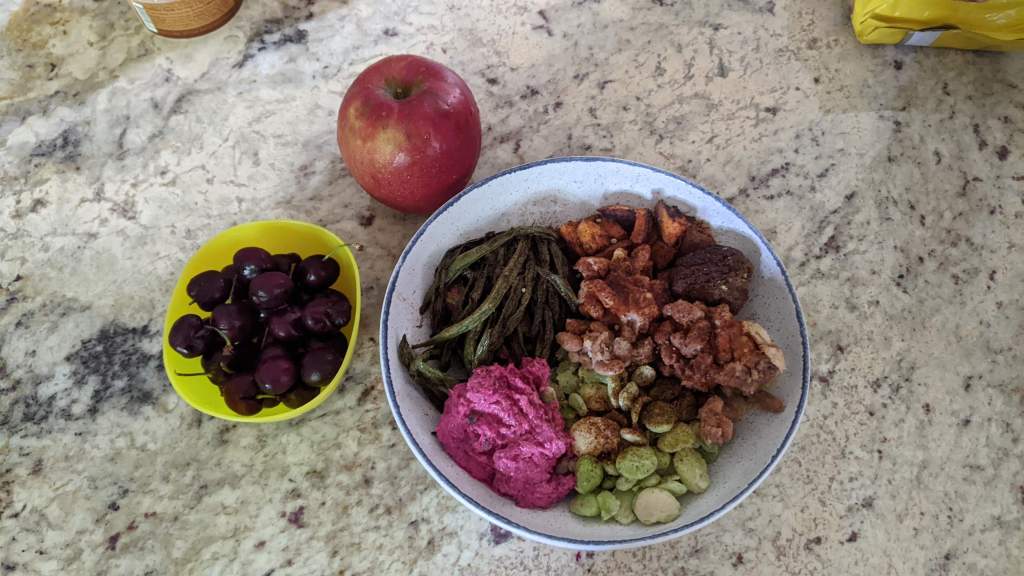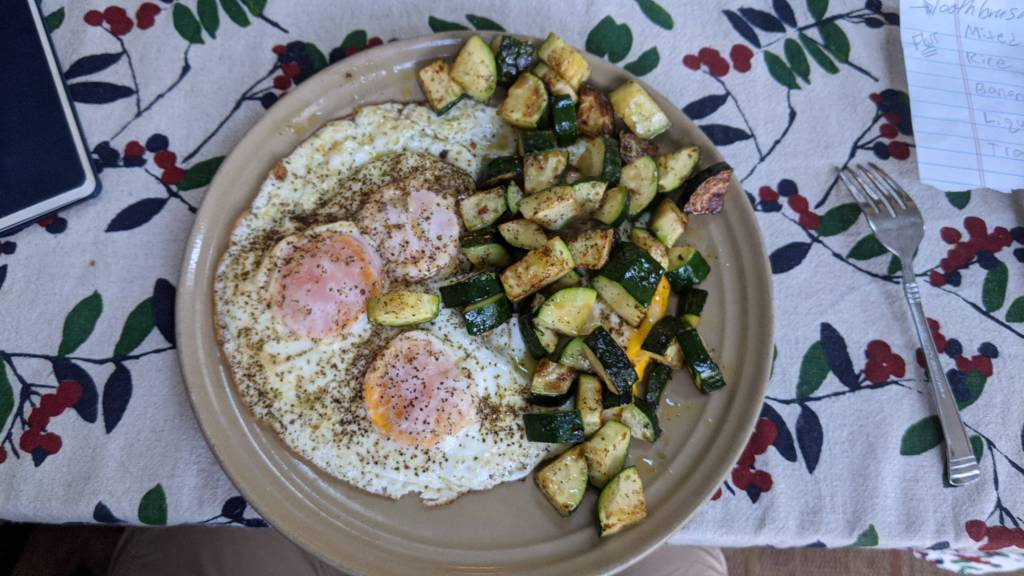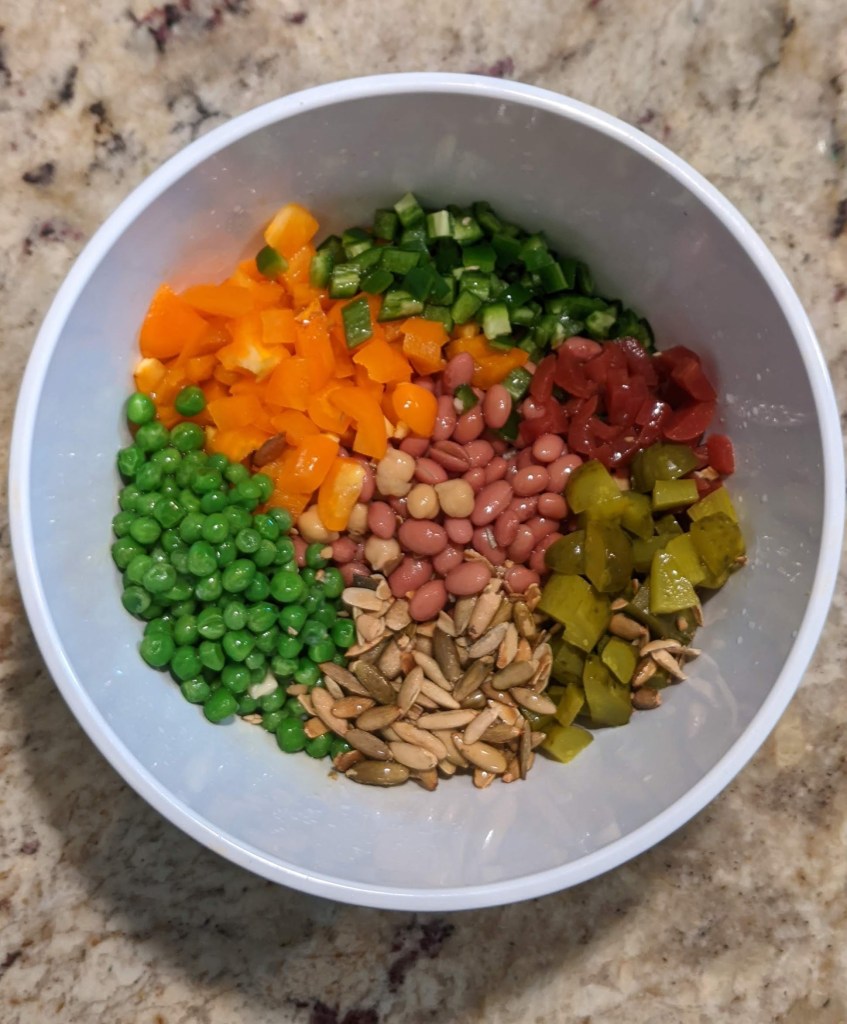In April of 2022 things had gotten out of hand. Or rather, they’d been out of hand for some time, years, really. I’d had enough. I’m a personal trainer. Should I look like this? I weighed 199 lb. (90kg) with plenty of muscle mass from consistent calisthenics but no muscle definition and way too much fat.
Time to make a change. Finally.
Motivated and informed by the kboges video “Nutrition Principles for Getting Lean and Muscular“, I began in earnest on April 13, 2022 and followed the guidelines closely. This has been my entire summer. And fall.

The main guidelines: Eat Real Food, Prioritize Protein, Reduce Meal Frequency.
Eat Real Food
You don’t have to be perfect, but the majority of what you eat should be real food. These are things your great-grandmother would recognize as food. It’s a polarized subject and I don’t want to proselytize about diet. I’m an omnivore; I mostly eat plants and I am trying to reduce my animal intake for environmental reasons. I do consume dairy, eggs, fish and seafood. You can certainly obtain the results I got while eating more or less meat than I did and you could do well as a vegetarian, pescatarian, or vegan. Those choices are up to you. Just make sure that most of what you consume is minimally processed, as close to the source as possible, and close to whole as you can get. For me, this includes a wide range of vegetables and fruit, olive oil and sometimes butter, eggs, some grains (usually whole grains), legumes and pulses (big fan!), chicken, fish, shellfish, beef (rarely), and pork (rarely). I should note that I experimented with vegetarianism during the 10 week period and ate no meat for 45 days and had consistent results. Experimenting with vegetarianism, or even just reducing your meat intake to a few times a week, can really help you see plants in a whole new light.











Prioritizing Protein
I don’t like to weigh or measure food, but if you don’t eat enough protein while losing weight, particularly if you don’t do strength training, you will lose muscle mass along with fat. And this is a very bad thing. As my doctor put it, muscle mass is “money in the bank”. As we age, we naturally lose muscle mass anyway. Losing muscle mass is associated with a wide range of problems as we grow older. Whether or not muscle can be gained while fat is lost is a subject of vigorous debate, but at the very least muscle mass can be preserved while fat is lost by strength training and eating enough protein. My rule of thumb is to make the protein the centerpiece of the dish. Vegetables and fruit can be eaten liberally because they are high in nutrients and low in calories, but among the higher calorie macronutrients (to also include fat and carbohydrate), protein should take priority. Examples include meat and dairy (if you are including them), beans and legumes, nuts and seeds, and tofu, tempeh and seitan.
Reduced Meal Frequency
You can call it Intermittent Fasting, Reduced Meal Frequency, Compressed Eating Window, or whatever you want. But the idea here is to not eat all the time. Sounds radical, right? There are many other benefits associated with this particular behavior than just weight loss, so if it’s something you are considering, you should look into it. I would also stress that reducing your meal frequency is by no means required for weight loss. But given that it DOES have other benefits, and one of its main strengths in the context of weight loss is hunger management, it seemed like a no-brainer. I was eating three (unmeasured) meals and at least one (unmeasured) snack before. I reduced this down to two, worked towards making one of them a large, unrestricted feed, and the other a smaller, early dinner. The grand goal was OMAD (One Meal a Day) but I never achieved it. But when I did consistently take one large meal and shortly after one small one, this is when the weight came off rapidly. Under the plan, “lunch” came at about 11:00, then noon, then 1:00 and so on until I was eating my first meal around 3:00 PM. It took me a few weeks to get used to this. This lunch would be as large as I wanted and almost always included a good protein source, lots of vegetables, and lots of fruit. Dinner would be a smaller version of lunch at 5:00 or 6:00. No snacks. Once I got used to it, this was fairly easy.
Training and Walking
Standard strength training for me is 2 or 3 sets of body-weight push, pull and squats per day, each set taken 2-3 repetitions short of failure. At the age of 57, mobility, flexibility and joint health are highly important, so I do most of my work on gymnastics rings or similar suspension trainers. I also work hard to keep my range of motion complete and my technique good. This for me is the gold standard for building and maintaining muscle mass. In addition to strength training, when I started the diet I made sure to get at least 10,000 steps a day, using the Google Fit app on my phone. Once my weight loss plateaued (to be discussed next), I tweaked both the workout strategy and the step goal.
Plateau, Energy Flux, and Maintenance
At about the nine or ten week point, my weight loss stopped. At this point I was at about 179 lb, which is 20 lb lower than when I started. Despite consistency, I did not see further weight loss for a couple of weeks. Additionally, I was feeling tired, unmotivated, and fairly weak. At this point I decided to stop dieting and instead took a “high energy flux” approach. I went back to three meals and snacks as desired (higher energy in) and increased my step goal to 15,000, and moved from intensity towards volume in my strength training (higher energy out). For strength training, instead of three hard sets of push, pull and squat, I moved to total rep goals for the day, which were usually 100-150 push-ups, 50-75 pull-ups and 200-250 squats. I would perform these workouts as quickly as I could with little rest between sets and each set taken far from failure. The goal here is to accrue volume over time. This is Density Training. For example, I might do 15 supersets of (easy) push-ups and rows, 10 reps each, with little to no rest between supersets. This would usually take 20 – 30 minutes. Then for squats I would do at least 20 sets of 10 with a 3-5 second rest between sets or 10 sets of 20 with 15-20 seconds rest between sets. Sometimes I would also do focused core work, such as 100-200 flutter kicks. But I was not consistent with the core work.
The “high energy flux” approach had dramatic effect. That is, I felt suddenly energized and stronger with elevated mood and increased vigor. Workouts were refreshing and I was able to increase reps consistently. As far as weight and body composition, the bad news is that I did not continue to lose weight. The good news is I did not gain weight. My body seemed to have reset itself at about 180 lb and the high energy flux became a sort of maintenance phase after the weight lost.
So these are two extremely potent tools that I was able to develop and are now securely my tool box: real food, protein priority and reduced meal frequency for weight loss and conscientious hunger-based eating and high energy output for maintenance. Moving forward I can pull out these tools and use them as needed. Very simple and reliable.
Vices and “Cheating”
I am lucky to have been born without much of a sweet tooth. Many people struggle with this particular “vice” and I feel fortunate that I can easily resist sweets. I can, however, easily plow through a bag of nacho cheese Doritos or potato chips. I did my best to avoid this for the most part, although a little bit from time to time is fine. It’s very important, I believe, to avoid self-punitive thoughts and Puritanical thinking. This includes things like calling food or eating behaviors “good” or “bad”, “clean” or “dirty”. Even the term “junk” doesn’t really sit well with me, as it will always have you feeling at least a little bit bad about yourself if you “give in”. Improving your body composition should not be about will power and resisting what you really want to do. If you really want to improve your body composition, then really wanting to eat an entire cake or family size bag of potato chips at one sitting really isn’t an option.
A bigger “vice” for me is beer and I’m one of those IPA snobs. It was important to me to see if I could achieve my weight loss goals without having to completely sacrifice this particular habit. Moderation is key of course, but I can safely tell you that if you are aware of your limits, you don’t have to give up everything you enjoy just because it might be considered “unhealthy”. Do not make this a contest of will power.

What’s Next?
Through a “high energy flux” approach I’ve been able to maintain my 20 lb weight loss while eating when hungry, stopping before completely full, and continuing to enjoy beer in moderation. How I feel overall has improved dramatically as a result. I’m stronger, the workouts are better, I feel more energy, and my mood has improved.
Time for Round 2. I’m going back to the weight loss eating strategy today and we’ll see how it goes. I’d like to get down to 174, which would be about 25 lb total and I think would allow me to get into the mid teens for body fat percentage. I haven’t been there in a very, very long time.
Fantastic. I, too have little to no sweet tooth but enjoy other low-speed, high-drag snacks like chips. I also love beer. The one thing I have trouble replicating from your routine is the walking. 10k steps is roughly 5 miles and most days I just can’t find that much time (due to work) without waking up early which is what I may have to do. Walking later in the day is fine certain times of the year but here in FL it’s miserably hot and humid for another month at least. Still, your progress is inspiring.
LikeLike
Many thanks for your feedback. Yes, it does take some time, and I’m not a huge fan of walking honestly. But my daughter likes to so we go together. Definitely walking after each meal has been very helpful. And I take the dog for a couple of walks and before I know it, the steps have added up! Understood regarding the whether. It’s hot and humid here in VA too but not nearly as bad as FL I’m sure. Nonetheless, my shirt is soaked when I get back.
LikeLike
Great results in a fairly short period of time, well done! Did you track protein? My problem is eating 1-2 meals a day makes it almost impossible to hit the recommended levels for an older person. I shoot for 150gms but find it hard to consistently get anywhere near that.
LikeLike
Thank you. I know what you mean. And no, I didn’t track protein. I really don’t like tracking things but I do think my protein intake is too low. My last scan indicated that I lost some muscle mass in addition to fat, so this is why I think it was too low. So how would 150 gm pan out in terms of servings and serving sizes?
LikeLike
Definitely indicative of your protein being to low. Frankly, i don’t think you can get there eating plant based protein. I would guess to hit your mark your going to have to increase meat consumption, it’s the most efficient way. Time restricted feeding also becomes somewhat problematic because when you’re eating 50gms of protein at a meal or more, your very satiated.
So you might have to widen your feeding window but that of course presents another problem. Chronically elevated mTor is great for building muscle but horrible for longevity. I’m 66 and concentrating on extending healthspan but wanting to maintain muscle mass is also important for that goal. I haven’t solved the mystery of finding the perfect balance. I do use Metformin and Rapamycin, but the protein issue has me scratching my head.
Check out a video by Jerry Teixeira on gaining muscle while in a calorie deficit. If you don’t know him he is in the body weight school.
LikeLiked by 1 person
Great information, thanks. I know what you mean about the protein and longevity conundrum.
LikeLike
This was a really great and inspiring read, Stephen! I’ve had a very frustrating year of trying to re-start my fat loss, including a few months of attempting tracking food using MacroFactor. (The fact that I’ve been traveling 30-40% of the time for work this year hasn’t helped.)
I’m taking your success as a challenge to myself. I’m at the same starting weight as you and we’re about the same height, so my plan is to feel a lot better about myself come our annual visit to my partner’s family on St. Croix at Christmas.
I am vegan and as such am adding protein powder to the mix, based on recommendations from Dr. Danielle Bellardo’s latest podcast episode (https://podcasts.apple.com/ca/podcast/eating-for-a-stronger-self-how-much-protein-do-you/id1447250475?i=1000577195473). Unlike you, I do have an absolutely vicious sweet tooth so the protein shakes will hopefully help in that regard as well.
LikeLike
Thanks Matthew and good luck to you. I have to say, I’m a little more inspired by the maintenance phse because I thought that once I returned to a standard eating schedule I’d just gain the weight right back, but that hasn’t happened. For me, two meals in a tight window is not sustainable at all. So I’m happy to view it as a tool in the tool box to be pulled out when needed. Keep me posted on your progress.
LikeLike
This was a really great and inspiring read, Stephen! I’ve had a very frustrating year of trying to re-start my fat loss, including a few months of attempting tracking food using MacroFactor. (The fact that I’ve been traveling 30-40% of the time for work this year hasn’t helped.)
I’m taking your success as a challenge to myself. I’m at the same starting weight as you and we’re about the same height, so my plan is to feel a lot better about myself come our annual visit to my partner’s family on St. Croix at Christmas.
I am vegan and as such am adding protein powder to the mix, based on recommendations from Dr. Danielle Bellardo’s latest podcast episode (https://podcasts.apple.com/ca/podcast/eating-for-a-stronger-self-how-much-protein-do-you/id1447250475?i=1000577195473).
LikeLike